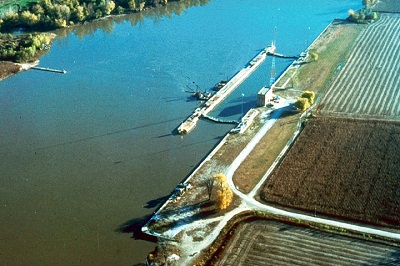
Unscheduled lock closures create costly ripple effects across the shipper supply chain – adding more than $1 billion in additional transportation expenses annually and disrupting state economies along U.S. inland waterways.
Those are the broad findings of a new, in-depth study by researchers from the Vanderbilt Engineering Center for Transportation and Operational Resiliency (VECTOR) and colleagues at the University of Tennessee. The study, released by the National Waterways Foundation (NWF) and the Maritime Administration (MARAD), examined four geographically different locks on the inland waterways system.
In addition to the economic impacts, the study highlights how the interconnected nature of our inland waterways – a strength that helped shape the country – is also a vulnerability.
Researchers looked at LaGrange Lock & Dam (Illinois), Lock & Dam 25 (Missouri), Markland Locks & Dam (Ohio) and Calcasieu Lock (Louisiana). An outage, for purposes of the study, is based on a one-year closure that triggers long-term changes by shippers and carriers.
In the cases of outages at LaGrange Lock & Dam and Lock & Dam 25, trucking to alternative waterway locations would mean an additional 500,000 loaded truck trips per year and an additional 150 million truck miles in the affected states. The extra financial burden on the shipper supply chain would exceed $1.5 billion annually.
“This study was a terrific opportunity to explore how disruptions to the transportation network can quickly propagate across the country with dramatic impacts to the supply chain costs of shippers who rely on the availability and reliability of the system,” said Craig Philip, research professor of civil and environmental engineering and the Vanderbilt principal investigator on the study.
Janey Camp, associate research professor of civil and environmental engineering, was closely involved in the study, too. Findings, she said, demonstrate the importance “of a single component of our aging infrastructure system.”

Most of the 170 locks and dams along 12,000 miles of connected inland waterways have exceeded their design life of 50 years and have suffered from “a persistent lack of reinvestment and environmental stresses associated with extreme weather events that magnify the system’s vulnerability,” the study said, causing choke points that affect commercial users first.
“As demonstrated in the report, the outage of just one lock, potentially any lock, for any significant amount of time not only affects the immediate vicinity, but also commerce and jobs in multiple states,” Camp said. “The cascading effects are potentially fully unrealizable and unmeasurable as supply chains and transportation costs affected and cost burdens transfer to customers.”
The results document what the study called the “extraordinary commercial value” of the waterway system to 18 states, especially Louisiana, Texas, and Illinois.
“This ground-breaking study reveals, for the first time, the broad range of economic and societal impacts of unscheduled lock outages. Real-world examples occurred during the September 2017 outages at Locks and Dams 52 and 53 in Illinois, and at the Inner Harbor Navigation Canal Lock in October 2017 in Louisiana,” said Daniel Mecklenborg, NWF Chairman.
“The study underscores that if the inland waterways were unavailable to transport the nation’s freight, the average number of trucks on rural highways would increase and result in significant impacts on safety, highway maintenance cost, and fuel consumption. Increased rail transportation safety impacts may occur at rail crossings, especially in urban areas, and in increased fuel consumption,” said Joel Szabat, MARAD Executive Director.
The agencies commissioned the study, “The Impacts of Unscheduled Lock Outages,” to examine the economic impacts of unscheduled lock outages and highlight economic benefits associated with reliable inland waterways navigation.
VECTOR researchers and economists Center for Transportation Research at the University of Tennessee conducted the analysis, which also examines the effects of unplanned lock outages on top commodities markets for each of the four areas. The findings show not only how adverse incidents affect inland waterway use but also negatively affect the environment, the livelihood of farmers, and commodity prices.
The results are relevant to other transportation modes, Philip said. In Nashville, for example, all refined petroleum products get to region through a single pipeline coming from the Gulf Coast.
“In recent years there have been several service interruptions on this pipeline that have affected availability and price of fuel at the pump,” he said. “Our work applied methodologies that could be used to estimate what the impact of an extended outage might be.”
It also shows how complex the problems of aging infrastructure really are, researchers said.
“As an engineer working on this project alongside economists from UT-Knoxville, this project reinforced my belief that the challenges we’re facing today and into the future are going to require truly interdisciplinary collaborations to even begin to address them,” Camp said.
See the full 97-page study, “The Impacts of Unscheduled Lock Outages,” here.
Media Inquiries:
Pamela Coyle, (615) 343-5495
Pam.Coyle@Vanderbilt.edu
Twitter @VUEngineering